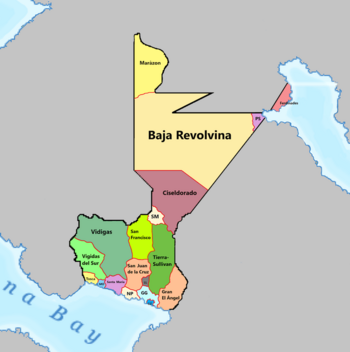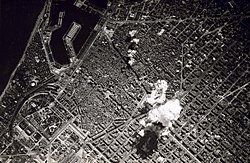San Castellino
Republic of San Castellino República de San Castellino (Stillian) | |
|---|---|
| Motto: "La República se dobla, pero no se rompe." "The Republic folds, but does not break." | |
| Anthem: "¡General, aquí estamos!" ("General, here we are!") | |
 Map of San Castellino | |
| Capital and largest city | Gazallenoa |
| Official languages | Stillian |
| Recognised national languages | San Castellino's Stillian (91%) Stilliann (56,01%) Lysiann (19,8%) Andesian (16,7%) |
| Ethnic groups (2012) | San Castellinos (69,2%) New-Lyrian (14,3%) Europans (6%) Iverican (5%) Alharuns (4%) Indigenous (0,3%) Others (1,2%) |
| Demonym(s) | San Castellinos |
| Government | Authoritarian Republic |
• Supreme Leader, President of the Republic | Sullivan Di Foxycionni |
• Secretary of State for the National-Capitalist Pact | La Joie Divine N'Golo |
| Legislature | National-Capitalist Pact |
| Population | |
• 2013 estimate | 19,530,000 |
| GDP (nominal) | 2020 estimate |
• Total | 131,462,760,000 |
• Per capita | 6,721 (2020) |
| Gini (2017) | very high |
| HDI (2014) | high |
| Currency | San Castellino's Peseta (SCP) |
| Time zone | UTC-5 (Alharun Central Time) |
• Summer (DST) | not observed |
| Date format | dd-mm-yyyy BCE/CE |
| Driving side | right |
San Castellino, officially the Republic of San Castellino (Iverican: República de San Castellino) is a large country located in western Mesothalassa in Alharu on Eurth. The country is situated between the Manamana Bay, the Bahia del Trébol and the Baie Ferdinande. San Castellino is divided in two by the plateau of the High-Chanchel, between the Mariachi desert and the equatorial forest. San Castellino has immediate borders with Mauridiviah and the Commune of Nouvelle-Lyrie. The country covers an area of XXX km2 including the few islets that belong to it, and the enclave of Ferdinades City which is populated by approximately 19,530 hundreds of inhabitants. The capital city Gazallenoa is the most populated city with a more than 10 millions inhabitants.
The country is officially a presidential republic, but de facto is an authoritarian republic led with an iron fist by general Sullivan Di Foxycionni and his National-Capitalist Pact. San Castellino is usually quiet in the foreign affairs due to a nationalist and isolationist policy.
Etymology
Originally called San Constantino by Stillian explorers - in honor of Saint Constantine - the name "San Castellino" appears for the first time in the 17th century in the memoirs of Juan Cristobal, a Stillian writer who immigrated to Gazallenoa. Apparently, the name is the result of a distortion of the original name by the local indigenous population. But it is really from the beginning of the 18th century that the name San Castellino is popularized.
Although San Castellino is the official name of the country, there are several nicknames, the most famous of which is the affectionate name "Castie" which even gave birth to the patriotic song "Me gustaría estar en Castie" ("I wish I was in Castie").
Geography
- Capital: Gazallenoa
- Enclave: Ferdinandes City
History
First signs of human presence
Pre-colonial history
Colonial history
(16th century - 18th century)
Independence
19th century
20th century
The economic crisis of 1927 also affected San Castellino, especially the nascent industrial sector, which was to emerge weakened forever. This economic crisis was accompanied by a sharp increase in unemployment and poverty, so that many towns (including some very important ones such as Ferdinades) were on the verge of bankruptcy. Extremist parties took advantage of the crisis - including the newly formed National Capitalist Pact - but not enough to come to power democratically. In January 1936 the elections for the President of the Council - the most important executive function in the 2nd Republic - took place. The social-democratic party won the elections for the first time under the banner of Juan Baptista. The army feared a rapprochement with the anarchist New Lyria and thus attempted a coup in Gazallenoa. The coup failed and the army revolted and quickly took control of the west of the country. The "democrats" led by Juan Baptista, more numerous but disorganised, had to face the "nationalists", less numerous but more organised, and led by General Rodrigo Rodriguèz. The political oppositions between the "democrats" (in reality composed of social democrats, liberals, anarchists and communists) will start to tear them apart from the inside at the end of 1938. The end of the civil war officially came on 6 September 1939 with the elimination of the last democratic forces and the capture of Juan Baptista (who was guillotined on 25 September of the same year). The civil war, which reduced the country to ruins, caused the emigration of more than 120,000 San Castellinos abroad, as well as plunging the country into a backwardness that would only accumulate over time.
21st century
Politics
President Sullivan Di Foxycionni is the Supreme Leader of the Republic while also serving as leader of the National-Capitalist Pact.
Economy
The national currency is the San Castellino's Peseta (SCP).
The economy of San Castellino, unlike most dictatorships, is very weakly controlled by the state. Indeed, the country's economic doctrine is conducted in accordance with the official ideology of the country, national-capitalism, which advocates ultra-liberalisation of the large majority of markets and almost total privatisation of services. As some famous examples, we can take the privatization of water, which is written into the constitution of San Castellino, or the fact that healthcare is managed by the Ministry of Economy.
The main sectors in San Castellino are oil, tobacco and agriculture. The oil sector in San Castellino is mainly controlled by foreign companies, notably by Galahinda through the company GalOil and Salvia. The San Castellinos tobacco and cigar industry is culturally and economically in the centre of the country. Indeed, San Castellinos luxury cigars are internationally renowned. That is why the management of this sector is totally controlled by the Alharu Tobacco Company, even though it is a private company. Finally, agriculture - especially the cultivation of bananas, coffee and cotton - also has an important share of the San Castellinos GDP. Moreover, recently, the cultivation of avocados, although very water-intensive and requiring the clearing of many hectares of forest, is increasingly practiced in San Castellino.


